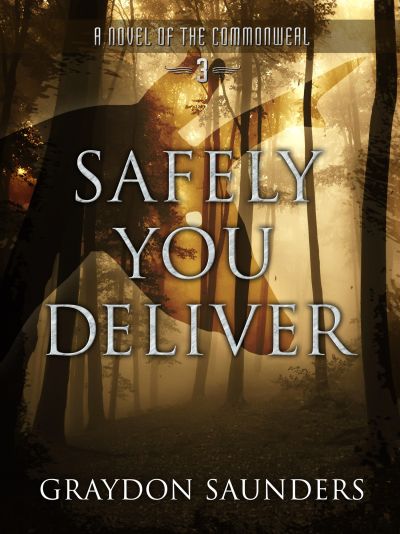Not quite Xavier’s School for Gifted Youngsters
Safely You Deliver (Commonweal, volume 3)
By Graydon Saunders

25 May, 2016
0 comments
Graydon Saunder’s 2016 Safely You Deliver continues the Commonweal series that began with The March North. It is a direct sequel to the second book in the series, A Succession of Bad Days.In fact, a reader could treat both of the later books as two halves of the same story. I generally don’t suggest back to back reading for series novels, but in this case it may be necessary.
The Commonweal’s experiment turning Edgar, Chloris, Dove, and Zora, a collection of humanoid potential existential threats — what superhero comics and movies might call “persons of mass destruction” — is still on-going. As the book opens, the end point of the experiment is still unclear.
What is clear is that Reems, one of the Commonweal’s neighbours, takes the Commonweal’s school for PMDs seriously enough to see it as a threat. They are worried enough to launch a pre-emptive attack, in the hopes of killing a potential dragon before it hatches out of the egg.
There are three main plot threads:
One chronicles the use of the students’ gifts for good. They are reworking the lands of the Commonweal, transforming the challenging ecosystems left by ambitious wizards keen on creating cool new life forms and unconcerned with the environmental consequences of having done so. In a world where triffids would probably not survive their first stroll through a deadly carnivorous meadow, this is not a farmer-friendly setting. Unlike modern dams, bridges and highways, which can basically be ignored once they are built, the essential infrastructure of this world requires ongoing upkeep to prevent it from vanishing under capital W Weeds.
Another plot covers the attack from Reems, which is less an act of aggression than of paranoid defensiveness. The only model people outside the Commonweal have for sorcerers, mages, and other magic users is “megalomaniacal monsters bent on world domination.” Adding “able to cooperate with their peers” to their talents would not look like a plus to people used to being crushed under the heel of this week’s Sauron. The group is working out how to survive future attacks on the Commonweal, which of course makes it that much more threatening to the neighbours … who cannot imagine that the group will use its powers for defence rather than conquest.
The final plot thread develops out of the previous two: Reems is not the only head of state who is extremely nervous about what exactly the students are becoming. The Commonweal itself is a bit worried. It is committed both to egalitarianism and rule of law; the PMD group cannot be treated as slaves and they will never be accepted as masters. The safest thing might be to end the experiment … perhaps by getting rid of Edgar, Chloris, Dove, and Zora.
~oOo~
As usual, while his editor has done an exemplary job of translating Saunder’s challenging idiolect into a more familiar vernacular, this is still a fairly dense book. It’s not especially long (even if you read it back to back with A Succession of Bad Days) but it may require the same investment of time and effort as a much longer book.
I found it interesting that a speculative fiction work set in a world that could be looked at as a horrifying post-holocaust world filled with Things That Want to Eat You and worse, a world in which international diplomacy mainly consists of sudden attempts at conquest or worse, a world in which established authority is legitimately afraid that they are creating something that could potentially break the Second Commonweal … this is a curiously optimistic book. The author pays a lot more attention to building neighbourly connections and maintaining a benevolent society than he does to fighting off the seemingly infinite supply of Horrible Things and Bad Neighbours.
The plot involving Zara and a unicorn is an example. Fantasy unicorns are generally bad news. Unicorns in this hellworld are even worse; this particular unicorn isn’t even worried about swans.
Swans were a large aquatic bird before someone got to them. The ones Wake remembers from the Northern hemisphere still are, someone might have got to them a little but they’re still birds and not creatures. None of the originals of these swans are extant, not anywhere we know about. Territorial, elegant, loud, just what a certain kind of pre-Commonweal sorcerer would want in the moat around their tower. They’re larger now, and what were feathers are not precisely illusion, the follicles make stable structures out of some sort of force. Anything material, up to at least catapult shot, I don’t know if anyone’s tried modern artillery, bounces off. Very brave people have broken big axes on swan necks, just before being brave didn’t keep them alive.
But the optimal way to deal with swan-killing unicorns isn’t to reach for a bigger hammer; It is to work out how to integrate unicorns into society without surrendering control to them.
Safely You Deliver can be purchased here.
